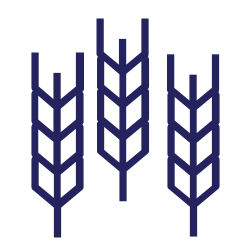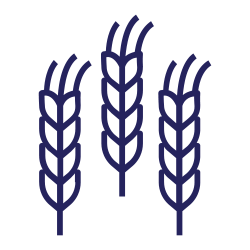Section Title
Pest Management in Winter Wheat – Diseases and Insects
- Winter Wheat
The life cycle of winter wheat can help avoid many pest problems. Its fall establishment, overwintering phase and early maturity can make winter wheat less prone to disease and insect issues compared with other spring cereal crops. However, this doesn’t mean that no pest management is necessary. Winter wheat production still has many pest challenges to look out for!
Diseases
Table 1: Winter wheat variety descriptions for disease resistance in the 2024 publication of Seed Manitoba.
Wheat streak mosaic virus
Wheat streak mosaic is a viral disease that primarily affects spring and winter wheat. Infected plants have stunted growth and produce fewer seeds that may be shriveled.
- Infection: Plants can be infected by the virus spreading between leaves of adjacent plants as they rub together. It can also be spread by the wheat curl mite. Both the mite and virus overwinter on winter wheat. In the spring, mites are blown from winter wheat fields to spring wheat fields, where they spend the summer. Come fall, if winter wheat is planted near spring wheat that is not yet mature, mites infected with the virus are blown back on to winter wheat, where the disease cycle is completed.
- Symptoms: Winter wheat fields often become infected in the fall, but symptoms are seldom visible until the spring, when growth resumes and temperatures are above 10 C. Symptoms may be the most apparent along field edges, where mites from neighbouring fields are most concentrated. Symptoms appear as small, yellow dashes that lengthen to form streaks parallel to the veins. In severe cases, the yellowing will expand and cause leaf death. Infected plants will be stunted. Infection in the fall causes the greatest yield losses, as fall-infected winter wheat plants will not produce grain. Winter wheat infected in the spring will also experience yield loss to varying extents, depending on the time of infection.
- Management: The most important method of control for wheat streak mosaic virus is to interrupt the life cycle of the wheat curl mite, which cannot survive more than 10 days without a living host plant. To avoid infection, elimination of the “green bridge” is important. Volunteer host plants should be controlled at least one week prior to planting and winter wheat should not be planted before spring wheat crops are mature. No pesticides are currently available for control of the wheat curl mite or the virus, however, the winter wheat variety AAC Elevate is resistant to the wheat curl mite. More information on wheat streak mosaic can be found here.
Fusarium head blight
Fusarium head blight (FHB) is a fungal disease affecting grasses such as winter wheat. Fusarium head blight can cause yield losses and grade reductions from the presence of Fusarium-damaged kernels and mycotoxins.
- Infection: The fungus causing FHB overwinters on crop residue, weeds and native plants. Spores are then carried by wind or rain to the wheat head. Weather is a very important contributor to the severity of FHB, as the disease is most likely to occur when high rainfall and temperatures occur during flowering.
- Symptoms: The most obvious symptom of FHB infection is often the presence of bleaching on the wheat head. Seeds will be shriveled, lighter in weight and chalky white or pink in colour.
- Management: If infection by FHB is a concern, consider seeding your winter wheat crop early in September to ensure your crop flowers early in the summer, avoiding the primary infection period. Fungicides can also be considered for suppression of FHB. As with many other diseases, crop rotation with non-susceptible crops is important. If possible, avoid planting winter wheat into corn stubble or near corn fields, as corn is highly susceptible to the fungus causing FHB. Winter wheat varieties that are less susceptible to FHB may also be chosen (Table 1).
Leaf rust
Leaf rust is a fungal disease affecting small-grain crops, including winter wheat, and can cause significant yield losses, particularly if infection occurs before flowering.
- Infection: Leaf rust overwinters in the southern United States and is blown into Manitoba by wind. Farmers can keep an eye on the rust situation in the U.S. early in the season and as the spores move north to get an indicator of the potential disease pressure in Canada.
- Symptoms: Leaf rust is visible as small, round pustules on the upper surface of leaves. They will be orange-red in colour and darken as the plant matures.
- Management: To control leaf rust, resistant varieties are available (Table 1). Fungicides can be applied if disease pressure, crop yield potential and weather conditions indicate high risk of losses. More information of leaf rust in winter wheat can be found here.
Stem rust
Stem rust is a fungal disease that can cause significant yield losses in winter wheat. Infected plants will produce fewer tillers, fewer seeds per head and those seeds that are produced will be small, shriveled and have poor milling quality.
- Infection: Like leaf rust, stem rust overwinters in the southern United States and is blown into Manitoba by wind.
- Symptoms: Stem rust pustules are typically larger than those of leaf rust and are dark reddish-brown in colour. They are found primarily on the stems of winter wheat, but they may also appear on the leaves and heads.
- Management: To control stem rust, resistant varieties are available (Table 1) and fungicides can be applied if necessary.
Leaf spot diseases
Leaf spot diseases of winter wheat may be caused by a variety of fungal pathogens, including those causing septoria leaf blotch and tan spot.
- Infection: Tan spot overwinters on crop residue, while septoria leaf blotch may also overwinter on the leaves of winter wheat.
- Symptoms: Both tan spot and septoria leaf blotch first appear as small, yellow or tan spots on the lower leaves that expand into oval lesions along the leaf veins. Tan spot lesions develop a small dark spot in the center, while septoria leaf blotch lesions will develop tiny black dots throughout the lesions.
- Management: Information regarding genetic resistance in winter wheat is not available from variety selection guides for both tan spot and septoria leaf blotch. Fungicides may be applied when infection is observed on lower leaves. A crop rotation should be maintained that contains non-cereal crops. Winter wheat should not be planted adjacent to spring wheat infected with leaf spot diseases.
- A note on physiological leaf spot: Physiological leaf spot (PLS) can easily be confused with other leaf spot diseases, but is not caused by a pathogen, so fungicides will not be an effective management tool. PLS is most common when cool, wet conditions are present, along with low chloride levels in the soil and plant. Like other leaf spot diseases, PLS symptoms begin as small yellow spots. As they develop, a brown centre will form and the spots will become more “blocky,” compared with tan spot lesions that are more oval in shape. In contrast to other leaf spot diseases, PLS has little impact on yield. More information is available from Manitoba Agriculture here.
Insects
Many of the insects of concern for winter wheat are also of concern for spring cereal crops. Below is a brief discussion of insect concerns and management strategies specific to winter wheat. For more information on insects of concern for cereal crops, visit Manitoba Agriculture’s insects webpage here.
Grasshoppers
Grasshoppers are generalists that feed on many crops, including winter wheat. Of the 85 species of grasshoppers in Manitoba, only four are potential pests of crops. The potential pest species are the migratory, two-striped, clear-winged and Packard grasshoppers. In the late summer and fall, newly emerging winter cereals can be a particularly attractive source of food for grasshoppers, which are a concern during hot, dry years.
- Identification: Any grasshopper that is flying prior to June is not a pest species. Grasshoppers with red, yellow, orange or black wings when flying are not pests, and any grasshoppers that make noise are not pests, as pest species are silent. For details on identifying pest species of grasshoppers, see this factsheet from Manitoba Agriculture.
- Symptoms of Infestation: Defoliation may be present, particularly on field margins. Fields may be scouted by counting the number of grasshoppers that jump in a one-metre-square area as you walk towards it. These counts should be completed at least five times throughout the field, noting areas of higher populations such as field margins and wet areas during droughts.
- Management: If grasshopper levels are high (11 to 20 per square metre) at field edges prior to planting, consider increasing the seeding rate for a 20-to-40-metre-wide strip around the field edges to compensate for potential damages and slow movement of grasshoppers to the rest of the field. If possible, seed near the end of the optimum planting window to reduce damage, and if defoliation is severe, replant after the first hard frost, when grasshopper populations have declined. Insecticides may be used if populations are high and are most effective before grasshoppers reach adulthood. Consider treating only the crop margin, as this is often adequate.
The life cycle of winter wheat can help avoid many disease and insect issues. However, disease and insect challenges should still be taken into consideration when planning for your winter wheat crop. Pest management is most effective when a variety of preventative measures are taken and pesticides are used as resourcefully as possible.
Additional resources
Manitoba Agriculture:
Agriculture and Agri-Food Canada:












